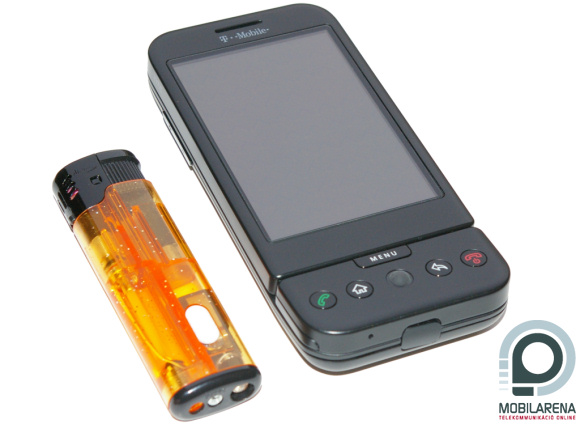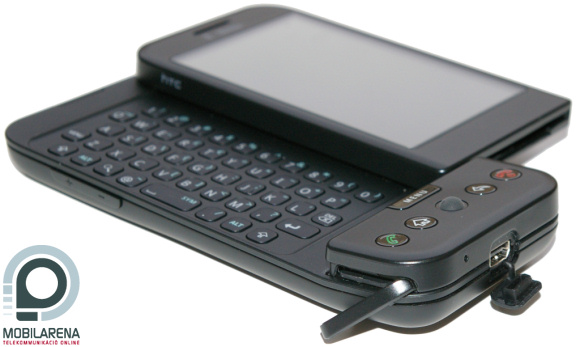Introduction, accessories
“You’re immortal, beautiful Android” – so does a Hungarian song go, probably based on a concept different than the one discussed in this article. Still, this line always pops in my mind when thinking about Google’s latest mobile phone operating system and its future. I could fill pages with information about the origins of the system and its aims, we’re planning to write a separate article about this, but now, in order to maintain the necessary amount of information, I’d like to write a couple of raw facts about this new hype. Probably not many of you know that Android is based on a monolithic Linux kernel, which has its story go back until July 2005, when the software giant has acquired Californian Android Inc. It has been already suspected back then that the company is about to develop a mobile operating system, but the time of the official announcement has been 2007 November 5. They have promised the following: a flexible system that is easy to develop and that provides developers a way to write managed code* in Java (*managed code: code processed on a virtual machine instead of the CPU) and that the phone will be usable with Java libraries from Google. And by the way almost the whole Android is open-source.
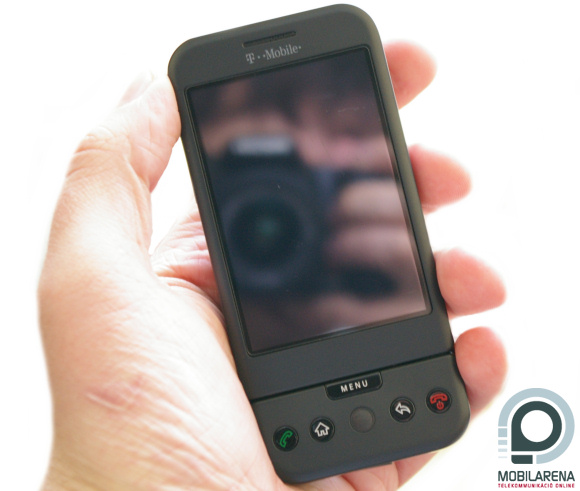
I have first met Android in this February at the Mobile World Congress in Barcelona. One piece of handset has been exposed at the stand of Texas Instruments. To tell the truth the white prototype didn’t impress me much back then, I only have some vague memories about its features and design. This might have been the reason why I have been discontented when answering the phone call from SpeedShop last week when they have told me that I am one of the first people to get one of the first Android phones from the country. The device first came without accessories, while at the second time it arrived in a white box that had a data cable, a carry case and a headset inside – it should have also had a charger and a memory card of an unknown size.
I had Android with me for four days. I’ve been using it constantly, but this time was not enough to get to completely know the new platform, no matter how hard I tried. It has been enough though to get used to the basic functions and to get an overall impression of the system. This is why I emphasize these parts besides the hardware in this review – but have no fear, as I’ve already mentioned there is a dedicated Android review in the making that will cover software and other possibilities.
Exterior
G1 is a real hinny: it has been made for T-Mobile, it runs Google’s operating system and it’s manufactured by HTC. By the way this is the first manufacturer from the Taiwanese manufacturer that has their logo on it even in spite of the fact that is made for exclusive distribution by a different company. This is a sign of the HTC brand becoming more and more known amongst average users. It’s another thing that if I hadn’t known who the manufacturer is, I would have never guessed that it’s made by HTC, as it looks completely different than their other handsets, I dare to say that it’s very ugly. Sticking to the facts I’d rather say that it’s large: it weighs 158 grams and its size is 117 x 55.7 x 17.1 mm. I can’t say that it uses premium quality materials either, it’s covered in soft, silky plastic everywhere.
The top of the front side has the distributor’s logo, while below it there is the 320 x 480 pixels large touchscreen with a 3.2” diagonal – yep, it’s the same resolution as of the iPhone’s. It’s a great thing that the display is also similarly high-quality, even though consider Apple’s phone as the de facto in this case, no matter the resolution. I think it’s unnecessary to go into more details, there are splendid colors, great contrast, exceptional readability in sunlight – I think these describe the screen the best. On the bottom we can find five keys and a “navigation ball”, which has been mostly seen on BlackBerry devices before and I’ve liked it a lot over there. As an interesting fact the case is not completely flat, the bottom part has a small arc pointing upwards, which makes G1 resemble a banana.
The back is rather puritan, we can only see the lens of the 3.2 megapixel camera and the handsfree speaker. The cover claps on the phone, we have to press a notch in order to take it off (this can be accessed by sliding the keyboard). The sides are similarly desolate, on the left there are the volume control keys and the microSD slot, while on the bottom there is a covered HTC ExtUSB connector, all other sides are empty.
After sliding the phone open we get to see the QWERTY keyboard. This is a rather standard thing for slider, but the opening mechanism is unique. It’s not really a slide, but a kind of arm, so the screen doesn’t only slides on a path when opened, but it also moves on an arc – it resembles butterfly windscreen-wipers from some Mercedes cars.

So the keyboard has a QWERTY layout, the keys are placed in five rows. I don’t want to over-hype it, but the keypad has an exceptionally good layout and it’s also highly usable, it’s really fast to type, which is probably also due to the large surface. The keys are placed logically; you can see that this has been designed with usability in mind.
Structure, speed, menu system video
T-Mobile G1 is a touchscreen handset, it’s hard to categorize it as a smartphone or a PDA – let’s just say that it’s simply Android. Where should I begin… maybe with the video of the menu, this might make it easier to have a full view of things.
Android has a kind of standby screen that can be scrolled left or right. It’s very spectacular because the background moves as well, and it might also be practical because we can organize our icons on the three interfaces. Yes, we can put icons over here, or a clock and a Google search bar, but this list will surely expand with the external applications – by the way, we can’t put stuff just anywhere, like in the case of TouchWIZ, the area is split in to sections, so there’s no risk of overlaps. The taskbar is on top, this has the status icons and also displays missed events – it’s awesome how the whole thing can be pulled down like a shutter, this is how we can see event details. The menu is on the bottom, we have to push the grey button up in order to make it visible.


Android is very easy to use. The thing is that it has a bit of everything, it doesn’t have such a simplified structure like iPhone, but it’s far from being as complicated as Windows Mobile or Symbian. We will be using three buttons: Menu lets us access the submenus and local menus of menu items or programs; the Home button takes us back to the standby screen, while the Arrow takes us one step back in the menu. It’s practically the same thing as on iPhone, but here these two functions are accessed with hardware keys, not by tapping the screen.


The system is quite mixed in terms of eye-candy. The icons of the main menu are quite plain, but there are all kinds of fade effects and animations, which pretty much spice up the overall image. Part of the popup windows make the background blurry, but it also happens in some cases that a window appears and then disappears by itself – for example when setting the alarm, there is a window, displayed for only a couple of seconds, that tells us how many hours there are left to sleep. When opening the keyboard the screen is rotated 90 degrees, there is no animation in this case, but the process is very fast, just like the whole system. Many have told about the handset that “this is as good as iPhone”. I’ve asked these people what are they talking about exactly, and the answer has always been the same: “Speed, of course!”. Still, the hardware is nothing extreme: a 528 MHz Qualcomm MSM7201A CPU, 192 MB RAM and 256 MB ROM, of which we have about 60 MB free for storing data.


PIM functions are just okay at first sight, but a more precise diagnosis could only be told after a couple of weeks of use. The alarm works even when the phone is turned off, the calendar has month, week and day views, it’s transparent and fast. There is a calculator that doesn’t only have basic features, we have some more advanced functions like sine or cosine as well. There are, however, some serious lacks as well: there is no voice recorder, stopwatch, countdown timer and there isn’t even a file browser. Of course we will surely have dozens of free apps to choose from, but they could have installed some default set of programs. I won’t detail software expandability for reasons I’ve already mentioned in the introduction, but I can say that the beta version of Android Market is already accessible from the menu, while under Settings we can see all installed programs. I have to note one of the greatest features: one day I have been connected to a WiFi network, and the system told me that there is a new software update (ROM update) available and asked me if I want to install it. Of course I’ve answered yes, it took about 3-4 minutes for the software to download, it has been installed in about the same amount of time and everything went on fine, all of my programs and settings have remained unaltered, just the OS has been updated. Wow. I think this should have been working this way on all handsets for years…
Phone calls, messaging, data transfer
Making calls is an awesome experience with G1, since sound quality is exceptionally good. During the test period many have asked me what kind of phone I’m using, as they have heard me really good and I can tell the same. The GSM module is quad-band (850/900/1800/1900 MHz), but the handset supports 3G and HSDPA too (7.2 Mbps). In lack of coverage we can also use EDGE or GPRS, and of course there is WiFi as well, supporting the 802.11b/g standards. Bluetooth is of version 2.0, but unfortunately it cannot be used for transferring data, only for paring with headsets – this is rather disappointing.
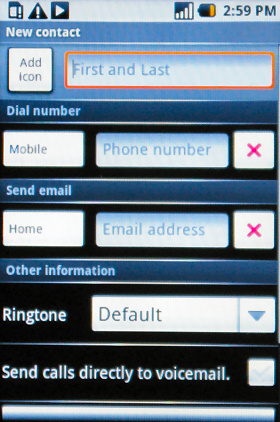
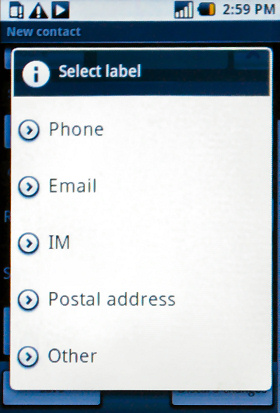
We can surely store an infinite number of entries in the contact list, as I couldn’t find any information about any limit for its capacity. As you can see on the pictures there are lots of extra fields, we can assign ringtones to contacts and we can also make calls of selected contacts automatically redirected to voice mail – an interesting feature I could say, it’s a kind of call filter. We can attach images to the contacts, by default we can see small Androids smiling at us, it’s nice and funny. The call log and the dialer are accessible from the phonebook, we can see four tabs on top, which help us in switching between the applications – I’ll save mathematicians from unnecessary thinking, the fourth tab has the most frequently dialed numbers. It’s very cool and also useful that the call log doesn’t only display the time of the call, but also the time elapsed since the call. There is voice dialing as well, of course we don’t have to record names at first, the software recognizes who we want to call.
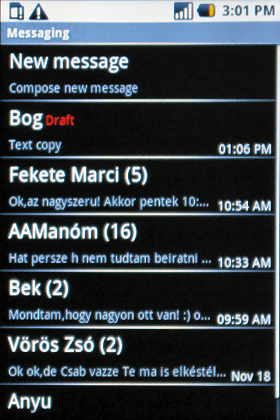

Messaging is great. There is an e-mail client, but we can access our Gmail account from a dedicated menu. You want attachments and access to authenticated IMAP servers? Android is okay with that. There is an IM client as well, it supports AIM, Google Talk, Windows Live and Yahoo! Messenger accounts. SMS messages are categorized by contacts in a chat-like view. I’ve seen such a feature thousands of times before, but I’m always happy about it. It’s great that we have text selection and copy/paste, even though it’s a bit hard to tap the entry area right in the middle – this is where we have to press in order to make the submenu appear. There is no virtual keyboard, we can only type with the real one, which is correct.
Google software and extras
I think it’s evident that a Google phone has lots of Google applications. First we have YouTube: it’s very fast, videos look great on the screen and it’s also very easy to use. The web browser is probably based on Chrome, which is less important than the fact that it’s great. I don’t say that it’s simply the best, as zooming is still easier in Safari (thanks to multi-touch), but Android’s browser is just as fast and it won’t pixelate unloaded parts when scrolling. It’s another nice feature that if we “zoom out” – switch to overview mode – we get to see a magnifier at our fingertip, so we can read and have an overall view of a large page at the same time.


Drums, trumpets please, here is the best feature: Google Maps. It is installed, it works, it’s fast, but the best is that it has Street View, which works in a really special way. For those who don’t know what this feature is: in the United States and some European countries Google roams with a couple of cars that have a camera with a view angle 360 grades. From here it’s simple: the cars take a picture at every X meter and we can have a virtual walk of these cities in Google Maps. So, the feature is available on Android, the picture loads, and we can look around only by moving the handset (!). Think of it as if you were standing in the place of the camera that took the picture, it’s dark, and the phone is a flashlight that shines in the direction where we are looking at. It’s an awesome fun to turn around with the phone in our hands, but of course the downside is that we can only use it if we’re standing and of course the whole thing depends on our social attitude, I mean not everyone likes to look like a fool in public.


That’s about the list of extra software, we also have an Amazon MP3 store and that’s all. There are smart and easy to use solutions, small innovations and some stupid lacks: that’s how one could sum up the software. I think the situation is not that bad as it has been in the case of iPhone a while ago, but it’s a fact that Android isn’t perfect either.
Multimedia
The camera’s resolution is 3.2 megapixels, it has autofocus, but no flash. There are no settings, we can’t record videos and image quality is terrible, the photos have noise, they are blurry, there are few colors and the automatic white balance misses sometime, which results in blueish images. There’s no use telling any more about this part, images are displayed below.

The greatest lacks of the musical part are the 3.5 mm jack and the FM radio, but the music player is a nice piece of software. Of course it’s not any better than the ones from the rivals, but it’s easy to use and it looks cool. We can sort tracks by ID3 tags, scrolling works fine, but there is unfortunately no equalizer. Sound quality is surprisingly good through handsfree, the default headset is mediocre, it doesn’t have a very clear sound.


I’ve almost forgot an important thing: the music player can run in the background, just like all other programs. Don’t think of a multitasking like in the case of Windows Mobile or Symbian, there is no task manager which could be used to switch between applications, but if we use the home key to exit from somewhere than our position is stored and we get the same view upon return. The only exception is the music player, as we can access it via the taskbar – unfortunately we can’t control playback from here, so in order to skip tracks we first have to pull the taskbar down and then tap the track title in order to make the application appear. By the way the player can’t play back movies.
Battery, summary
The battery, labeled HTC Innovation, has a capacity of 1150 mAh and it can be swapped out. This power is unfortunately not enough for Android, it didn’t take it for even a day at me, but of course I’ve been tampering a lot with it, the WiFi was turned on lots of time, and I’ve been talking about one-one and a half hour every day. According to factory data talk time is 5 hours and 20 minutes, I think this is completely unrealistic, but I think G1 can take it for a day when not using the WiFi.
Summary: first we should make it clear that when rating the handset I practically rate Android itself, as this is the first handset with such a system. Of course we could abstract from this and then I’d say that G1 is a well-assembled, large and ugly handset that sports a great screen, an awesome keyboard and robust hardware. And then add Android. Android, which is new, a bit immature, but I think it’s very promising. Unfortunately I just have to compare to iPhone’s operating system, as it’s about that fast, it’s easy to use and it’s hard to make things go wrong. There is still one important different: it’s easier to develop software for it and opposed to Apple, Google is a great supporter of developers. I am sure that in a couple of months we will have tons of good and better applications, and I also trust that one of the manufacturers will launch a handset with a better design that might even have a good camera. I’m happy that you’re here Android.
 |
| T-Mobile G1 |
Bocha
Translated by Szaszati
The handset has been provided by www.speedshop.hu, thanks.
Specifications
| T-Mobile G1 | ||
 | Technology | GSM/GPRS/EDGE 850/900/1800/1900 MHz UMTS/HSDPA 2100 MHz |
| Operating system | Google Android | |
| Size | 117 x 55.7 x 17.1 mm | |
| Weight | 158 grams | |
| CPU | 528 MHz Qualcomm MSM7201A | |
| ROM / RAM | 256 / 192 MB | |
| Display | 3.2” diagonal, 320 x 480 pixel resolution, 16 bit color depth touchscreen | |
| Expandability | microSD | |
| WiFi | 802.11b/g | |
| Infra / Bluetooth | none / 2.0 (A2DP too) | |
| GPS receiver | present | |
| Audio | HTC ExtUSB output, microphone, mono speaker | |
| Camera | 3.2 megapixels, autofocus | |
| Battery | 1150 mAh changeable Li-Ion | |
| Other | QWERTY keyboard, gyroscope | |
